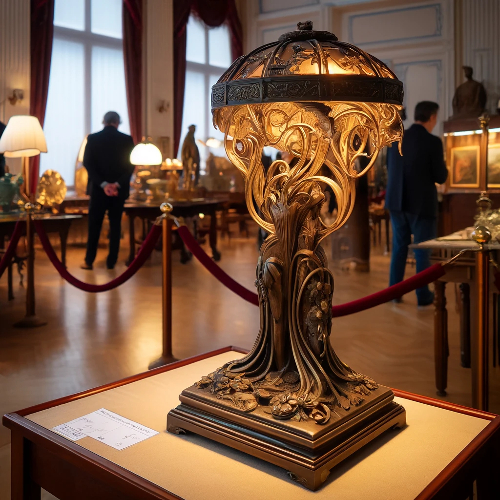Art Nouveau is an artistic movement that began in the late 19th century and flourished until the early 20th century. It is characterized by sinuous lines, nature-inspired patterns and an organic aesthetic. Among the emblematic objects of this style, the Art Nouveau bronze lamp occupies a special place. Combining the durability of metal with the delicacy of natural shapes, these lamps are true works of art. In this article, we will explore the history, characteristics and importance of Art Nouveau bronze lamps, as well as tips for incorporating them into modern decoration.
The History of Art Nouveau Bronze Lamps
The Art Nouveau movement emerged in the late 19th century in Europe, spreading rapidly across North America and beyond. It developed in reaction to rigid academic styles and increasing industrialization, advocating a return to craftsmanship and natural inspiration. The Art Nouveau lamps in bronze are a perfect example of this philosophy, using noble materials and artisanal techniques to create unique and elegant pieces.
One Old Art Nouveau lamp often reflects the craftsmanship of the craftsmen of the time, with hand-carved details and organic patterns. Artists like Émile Gallé and Louis Comfort Tiffany helped popularize this style, each bringing their own unique vision and techniques.
The Characteristics of Art Nouveau Bronze Lamps
The Art Nouveau lamps in bronze are distinguished by several specific features that make them immediately recognizable and appreciated by art and design lovers.
Materials & Manufacturing
Bronze is a robust and durable material, ideal for creating lamps that can stand the test of time. One Art Nouveau bronze lamp often combines a bronze base with a glass shade, creating a harmonious contrast between the strength of metal and the delicacy of glass. The Tiffany style lamps are particularly famous for this combination, using colored stained glass for their lampshades.
Patterns and Shapes
Inspired by nature, the Art Nouveau lamps feature floral patterns, curved lines, and organic shapes. The bronze bases can be adorned with leaves, flowers, or even animal figures, with every detail carefully carved to capture the essence of nature. One Art Nouveau lamp Gallé is a perfect example of this attention to detail, with engraved or enamelled designs on the glass and finely crafted bases.
Craft Techniques
The Art Nouveau lamps in bronze are often handmade, using artisanal techniques passed down from generation to generation. Lost wax, an ancient casting technique, is commonly used to create detailed bronze bases. Each lamp is therefore a unique piece, a reflection of the talent and know-how of the craftsman.
Choosing Art Nouveau lamps in Bronze for your decoration

Choose a Art Nouveau bronze lamp in a contemporary décor can bring a touch of charm and timeless elegance. Here are some tips for a successful integration:
Contrast and Harmony
Combine Art Nouveau lamps with contemporary furniture to create an interesting visual contrast. For example, a Art Nouveau lamp Gallé can be placed on a contemporary desk for a striking effect. Mixing styles can enrich the aesthetic of the room, adding depth and character.
Focal Points
Use Art Nouveau lamps as focal points in a room. Their unique design and intricate details naturally attract attention and can serve as a centerpiece. For example, a Art Nouveau Tiffany lamp With its colorful stained glass shade can brighten up a living room or dining room in style.
Natural Themes
Complete the Art Nouveau lamps with other decorative elements inspired by nature. Plants, floral-patterned textiles, and wooden furniture can enhance the lamp's organic aesthetic. One Art Nouveau lamp 1900 integrated into a green interior creates a harmonious and soothing atmosphere.
Gallé and Tiffany Lamps: Symbols of Art Nouveau
The Gallé lamps and the Tiffany Art Nouveau lamps are among the most prized by collectors and Art Nouveau enthusiasts. Émile Gallé, famous for his glass creations, left his mark on the history of Art Nouveau with his delicately carved and painted lampshades. Each Gallé lamp is a unique work of art, reflecting the inspiration of nature and the talent of its creator.
Similarly, the Tiffany Art Nouveau lamps, designed by Louis Comfort Tiffany, are famous for their colorful stained glass windows and intricate patterns. Tiffany lampshades, often paired with bronze bases, create beautiful plays of light that transform the atmosphere of a room. One Art Nouveau Tiffany lamp is not only a light fixture, but also a light sculpture that embellishes any interior.
Comparison with Art Deco Lamps
Although Art Nouveau and Art Deco are two distinct movements, they share a passion for elegant design and quality materials. One Art Deco lamp 1930 stands out for its geometric lines and more industrial aesthetic, contrasting with the organic shapes and natural patterns of Art Nouveau. Incorporating elements of both styles can create an eclectic and sophisticated interior. For example, a Old Art Nouveau lamp can be placed next to a Art Deco lamp 1930 to juxtapose the two styles and enrich the atmosphere of the room.
Antique Table Lamps
The antique desk lamps, whether in Art Nouveau or Art Deco style, bring a touch of elegance to a workspace. One Old Art Nouveau lamp on a modern desk creates an interesting contrast, while providing a functional light source. The antique desk lamps are often equipped with articulated arms or adjustable heads, allowing for flexible and convenient use.
Conclusion
The Art Nouveau lamps in bronze are not just sources of light, but works of art that capture the essence of an era rich in creativity and innovation. Whether it is a Gallé lamp, a Tiffany style lamp or a Art Nouveau bronze lamp, each piece brings a touch of elegance and sophistication to any interior.
By incorporating these fixtures into your décor, you can not only enhance the lighting in your space, but also add a touch of refinement and character. The Art Nouveau lamps are timeless treasures that continue to captivate and inspire design lovers across generations.

